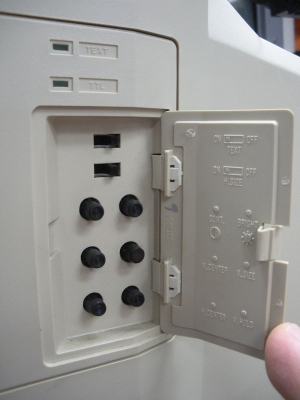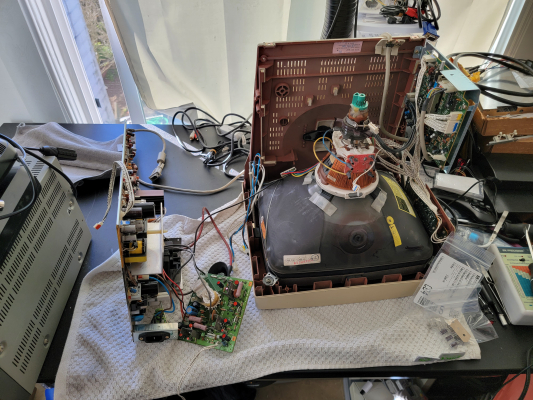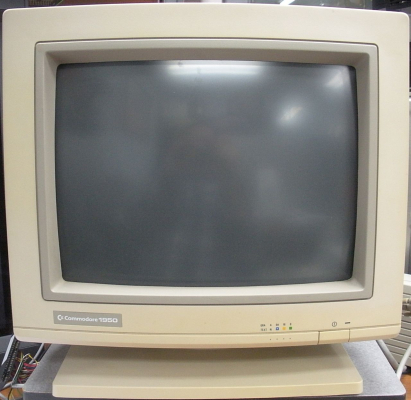Commodore 1950
May 26, 2024, 3:53 am
January 22, 2025, 1:42 am
Summary
A rebrand of the AOC CM314 "The Intelligent Monitor". You may recognize that slogan - it's lifted from the first multisync monitor ever made... the NEC Multisync 1 from 1986. That's only the beginning of the similarities between the two monitors. The input card for the VGA port that handles the sync timings and has the physical rear switch for Analog / TTL is the exact same PCB design from the original NEC Multisync - my best guess is that NEC licensed this design to other manufacturers in the early 90s. The input card PCB doesn't say NEC anywhere on it and the ICs that were originally made by NEC are now clones from Malaysia. The mainboard is absolutely full of NEC ICs however.
- The M34JCA30X15 picture tube, now made by Hitachi instead of NEC, has the exact same dot pitch, line count, and deflection angle as the NEC Multisync.
- The service manual shares several pages of copy from the NEC service manual, with nothing changed other than the name of the monitor and minor formatting.
- The user controls area is the exact same part from a NEC Multisync, however AOC chose to mount it on the side of the case instead of the top - likely to make it more convenient for the user to access and read while remaining seated.
The 1950 also shares the same operational quirks as the NEC Multisync:
- The H-Width switch rarely provides enough additional width to the raster to make a worthwhile difference.
- The horizontal centering is lost between different scan rates and has to be recalibrated each time you switch to a new one.
And here are the main differences:
- Different case design
- All internal PCBs from the original NEC chassis design (except the unbranded NEC input card) have been consolidated into a single low-cost mainboard which drives everything else related to the monitor.
- The internal potentiometer adjustments for background and foreground raster size by different scan rates are gone - presumably it is now a fixed value.
Manuals
Notes
- While this monitor does accept csync, unlike the NEC Multisync monitor it does not accept standard 0.7vpp signal levels and requires sync to be TTL. Interestingly it does not care if HV sync is TTL level or not, both will work fine.
Common Repairs
- The quality control on the factory is generally very poor with these. You will want to open it up and check every single cable connection for cold solder joints (I just touched them all up regardless) and touch up the flyback pins as well. Don't forget the cable connections on the neckboard too.
- Another quality control issue is the machine they used to cut all the legs off the through-hole components during manufacturing was apparently very bad at its job - you will likely find many doubled-up or hanging legs if you examine the bottom of the main PCB. I suggest carefully cutting all of these away and blowing the board with compressed air after to make sure there aren't any metal fragments hanging around.
- Recommended to recap the neckboard - the 470uf 10v caps and the 47uf 16v caps are likely bad.
Gallery




| Specifications | |
|---|---|
| Brand: | Commodore |
| Manufacturer: | AOC |
| Model: | 1950 |
| Series: | 1000 series |
| Viewable Size: | 13" |
| Inputs: | VGA, RGB, Digital RGB |
| Sync: | HV Sync, CSYNC, Sync on Green, Sync over Composite, Sync on Luma |
| Native Resolutions: | VGA, 240p, 480i, 480p |
| Linecount: | 600 TVL |
| Horizontal Scan Range: | 37 kHz |
| Formats: | NTSC, PAL |
| Aspect: | 4:3 |
| Adjustments: | Internal Potentiometers, External Potentiometers |
| Focus Type: | Single |
| Tube: | Hitachi , M34JCA30X15 , M34JCA30X |
| Deflection: | 90° |
| Mask: |
Shadow

|
| Pitch: | 0.31 mm |
| Application: | Computer Monitor |
| Cabinet Material: | Plastic |
| Launched: | 1991 |
| Country of Manufacture: | Taiwan |
| Mounting: | Desk Stand |
| Degaussing: | Automatic on Power-on |
| Tag: | Needs Owners Manual, Needs Measurements |

 This work is licensed under a
This work is licensed under a